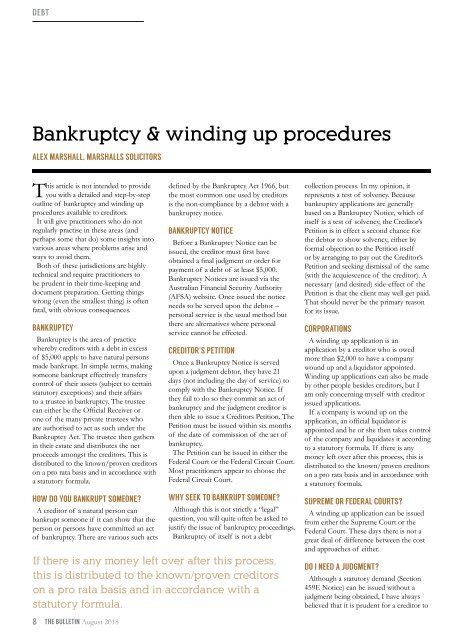The Bulletin August 2018
You also want an ePaper? Increase the reach of your titles
YUMPU automatically turns print PDFs into web optimized ePapers that Google loves.
DEBT<br />
Bankruptcy & winding up procedures<br />
ALEX MARSHALL, MARSHALLS SOLICITORS<br />
This article is not intended to provide<br />
you with a detailed and step-by-step<br />
outline of bankruptcy and winding up<br />
procedures available to creditors.<br />
It will give practitioners who do not<br />
regularly practise in these areas (and<br />
perhaps some that do) some insights into<br />
various areas where problems arise and<br />
ways to avoid them.<br />
Both of these jurisdictions are highly<br />
technical and require practitioners to<br />
be prudent in their time-keeping and<br />
document preparation. Getting things<br />
wrong (even the smallest thing) is often<br />
fatal, with obvious consequences.<br />
BANKRUPTCY<br />
Bankruptcy is the area of practice<br />
whereby creditors with a debt in excess<br />
of $5,000 apply to have natural persons<br />
made bankrupt. In simple terms, making<br />
someone bankrupt effectively transfers<br />
control of their assets (subject to certain<br />
statutory exceptions) and their affairs<br />
to a trustee in bankruptcy. <strong>The</strong> trustee<br />
can either be the Official Receiver or<br />
one of the many private trustees who<br />
are authorised to act as such under the<br />
Bankruptcy Act. <strong>The</strong> trustee then gathers<br />
in their estate and distributes the net<br />
proceeds amongst the creditors. This is<br />
distributed to the known/proven creditors<br />
on a pro rata basis and in accordance with<br />
a statutory formula.<br />
HOW DO YOU BANKRUPT SOMEONE?<br />
A creditor of a natural person can<br />
bankrupt someone if it can show that the<br />
person or persons have committed an act<br />
of bankruptcy. <strong>The</strong>re are various such acts<br />
8<br />
THE BULLETIN <strong>August</strong> <strong>2018</strong><br />
defined by the Bankruptcy Act 1966, but<br />
the most common one used by creditors<br />
is the non-compliance by a debtor with a<br />
bankruptcy notice.<br />
BANKRUPTCY NOTICE<br />
Before a Bankruptcy Notice can be<br />
issued, the creditor must first have<br />
obtained a final judgment or order for<br />
payment of a debt of at least $5,000.<br />
Bankruptcy Notices are issued via the<br />
Australian Financial Security Authority<br />
(AFSA) website. Once issued the notice<br />
needs to be served upon the debtor –<br />
personal service is the usual method but<br />
there are alternatives where personal<br />
service cannot be effected.<br />
CREDITOR’S PETITION<br />
Once a Bankruptcy Notice is served<br />
upon a judgment debtor, they have 21<br />
days (not including the day of service) to<br />
comply with the Bankruptcy Notice. If<br />
they fail to do so they commit an act of<br />
bankruptcy and the judgment creditor is<br />
then able to issue a Creditors Petition. <strong>The</strong><br />
Petition must be issued within six months<br />
of the date of commission of the act of<br />
bankruptcy.<br />
<strong>The</strong> Petition can be issued in either the<br />
Federal Court or the Federal Circuit Court.<br />
Most practitioners appear to choose the<br />
Federal Circuit Court.<br />
WHY SEEK TO BANKRUPT SOMEONE?<br />
Although this is not strictly a “legal”<br />
question, you will quite often be asked to<br />
justify the issue of bankruptcy proceedings.<br />
Bankruptcy of itself is not a debt<br />
If there is any money left over after this process,<br />
this is distributed to the known/proven creditors<br />
on a pro rata basis and in accordance with a<br />
statutory formula.<br />
collection process. In my opinion, it<br />
represents a test of solvency. Because<br />
bankruptcy applications are generally<br />
based on a Bankruptcy Notice, which of<br />
itself is a test of solvency, the Creditor’s<br />
Petition is in effect a second chance for<br />
the debtor to show solvency, either by<br />
formal objection to the Petition itself<br />
or by arranging to pay out the Creditor’s<br />
Petition and seeking dismissal of the same<br />
(with the acquiescence of the creditor). A<br />
necessary (and desired) side-effect of the<br />
Petition is that the client may well get paid.<br />
That should never be the primary reason<br />
for its issue.<br />
CORPORATIONS<br />
A winding up application is an<br />
application by a creditor who is owed<br />
more than $2,000 to have a company<br />
wound up and a liquidator appointed.<br />
Winding up applications can also be made<br />
by other people besides creditors, but I<br />
am only concerning myself with creditor<br />
issued applications.<br />
If a company is wound up on the<br />
application, an official liquidator is<br />
appointed and he or she then takes control<br />
of the company and liquidates it according<br />
to a statutory formula. If there is any<br />
money left over after this process, this is<br />
distributed to the known/proven creditors<br />
on a pro rata basis and in accordance with<br />
a statutory formula.<br />
SUPREME OR FEDERAL COURTS?<br />
A winding up application can be issued<br />
from either the Supreme Court or the<br />
Federal Court. <strong>The</strong>se days there is not a<br />
great deal of difference between the cost<br />
and approaches of either.<br />
DO I NEED A JUDGMENT?<br />
Although a statutory demand (Section<br />
459E Notice) can be issued without a<br />
judgment being obtained, I have always<br />
believed that it is prudent for a creditor to


















